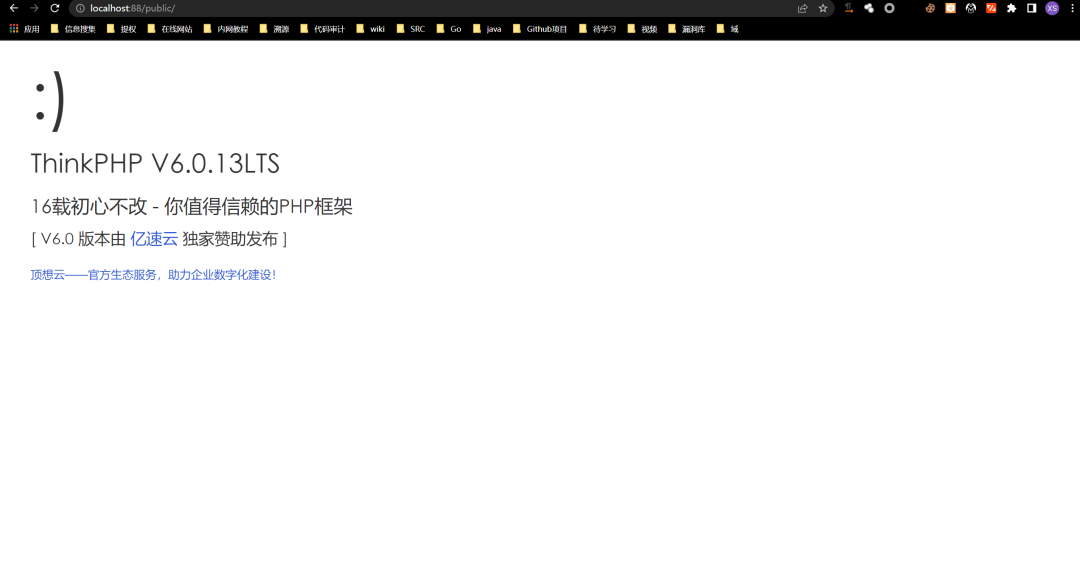
composer下载链接
https://getcomposer.org/doc/00-intro.md
安装ThinkPHP6.0.13,需要本地PHP>7.2
composer create-project topthink/think tp
使用PHPStudy搭建安装完成
漏洞演示
断点分析
首先反序列化第一步走的就是__destruct()魔术方法,通过全局搜索这个魔术方法,找到这里最有可能是反序列化的入口点。这个AbstractCache类是Psr6Cache的父类
public function \_\_destruct()
{
if ($this->lazySave) {
$this->save();
}
}
接着$this->save就会跳转到Psr6Cache类的save方法
public function save()
{
$item = $this->pool->getItem($this->key);
$item->set($this->getForStorage());
$item->expiresAfter($this->expire);
$this->pool->save($item);
}
这里在初始化的时候传入与了一个$pool变量
$b = new think\log\Channel();
$a = new League\Flysystem\Cached\Storage\Psr6Cache($b);
第一步实例化了Psr6Cache对象,在初始化的时候传入第一个参数,$this->pool
public function \_\_construct(CacheItemPoolInterface $pool, $key = 'flysystem', $expire = null)
{
$this->pool = $pool;
$this->key = $key;
$this->expire = $expire;
}
在Psr6Cache类中,$this->pool->getItem调用时,出发了魔术方法_call,因为Channel对象中没有getItem方法。此时也会执行构造方法
public function save()
{
$item = $this->pool->getItem($this->key);
$item->set($this->getForStorage());
$item->expiresAfter($this->expire);
$this->pool->save($item);
}
在Channel类中的_call方法,__call方法中又调用了$this->log方法
public function log($level, $message, array $context = \[\])
{
$this->record($message, $level, $context);
}public function \_\_call($method, $parameters)
{
$this->log($method, ...$parameters);
}
接着跟踪$this->record方法,这个方法是用来记录日志信息的。这里最终会调用到$this->save方法
# 记录日志信息
public function record($msg, string $type = 'info', array $context = [], bool $lazy = true)
{
if ($this->close || (!empty($this->allow) && !in_array($type, $this->allow))) {
return $this;
}
if (is\_string($msg) && !empty($context)) {
$replace = \[\];
foreach ($context as $key => $val) {
$replace\['{' . $key . '}'\] = $val;
} $msg = strtr($msg, $replace);
}
if (!empty($msg) || 0 === $msg) {
$this->log\[$type\]\[\] = $msg;
if ($this->event) {
$this->event->trigger(new LogRecord($type, $msg));
}
}
if (!$this->lazy || !$lazy) {
$this->save();
}
return $this;
来到save方法,save方法中又调用到了$this->logger->save()
这里在初始化的时候定义了$this->logger = new think\log\driver\Socket() ,所以在调用的时候会去往Socket类
/\*\*
\* 保存日志
\* @return bool
\*/
public function save(): bool
{
$log = $this->log;
if ($this->event) {
$event = new LogWrite($this->name, $log);
$this->event->trigger($event);
$log = $event->log;
} if ($this->logger->save($log)) {
$this->clear();
return true;
}
return false;
}
来到think\log\driver\Socket()下的save方法
此时$this->config['format_head'] = [new \think\view\driver\Php,'display']
这里的$this->app->invoke是调用反射执行callable 支持参数绑定,进行动态反射调用
/\*\*
\* 调试输出接口
\* @access public
\* @param array $log 日志信息
\* @return bool
\*/
public function save(array $log = \[\]): bool
{
if (!$this->check()) {
return false;
} $trace = \[\];
if ($this->config\['debug'\]) {
if ($this->app->exists('request')) {
$currentUri = $this->app->request->url(true);
} else {
$currentUri = 'cmd:' . implode(' ', $\_SERVER\['argv'\] ?? \[\]);
}
if (!empty($this->config\['format\_head'\])) {
try {
$currentUri = $this->app->invoke($this->config\['format\_head'\], \[$currentUri\]);
} catch (NotFoundExceptionInterface $notFoundException) {
// Ignore exception
}
}
......
跟踪$this->app->invoke
public function invoke($callable, array $vars = \[\], bool $accessible = false)
{
if ($callable instanceof Closure) {
return $this->invokeFunction($callable, $vars);
} elseif (is\_string($callable) && false === strpos($callable, '::')) {
return $this->invokeFunction($callable, $vars);
} else {
return $this->invokeMethod($callable, $vars, $accessible);
}
}
这里的判断循环最终会进入到return $reflect->invokeArgs(is_object($class) ? $class : null, $args);
通过这里的反射方法来到Php类下的display方法,$calss是一个对象类,$args就是对象类下的方法
public function invokeMethod($method, array $vars = \[\], bool $accessible = false)
{
//$method = think\\view\\driver\\Php
if (is\_array($method)) {
\[$class, $method\] = $method; $class = is\_object($class) ? $class : $this->invokeClass($class);
} else {
// 静态方法
\[$class, $method\] = explode('::', $method);
}
try {
//ReflectionMethod回调方法
$reflect = new ReflectionMethod($class, $method);
} catch (ReflectionException $e) {
$class = is\_object($class) ? get\_class($class) : $class;
throw new FuncNotFoundException('method not exists: ' . $class . '::' . $method . '()', "{$class}::{$method}", $e);
}
$args = $this->bindParams($reflect, $vars);
if ($accessible) {
$reflect->setAccessible($accessible);
}
return $reflect->invokeArgs(is\_object($class) ? $class : null, $args);
}
官方文档
此时调用方法的参数
输出一个回调方法,$calss是类名,$method是方法
$reflect = newReflectionMethod($class, $method);
通过$this->invokeArgs方法将参数传递给类下的方法
$reflect->invokeArgs(is_object($class) ? $class : null, $args);
通过图可以看出值传递的过程
来到display方法中,$content就是传递的值,然后拼接到了eval去执行命令
public function display(string $content, array $data = \[\]): void
{
$this->content = $content; extract($data, EXTR\_OVERWRITE);
eval('?>' . $this->content);
}
如有侵权,请联系删除
本文来源于奇安信攻防社区
好文推荐
如有侵权请联系:admin#unsafe.sh